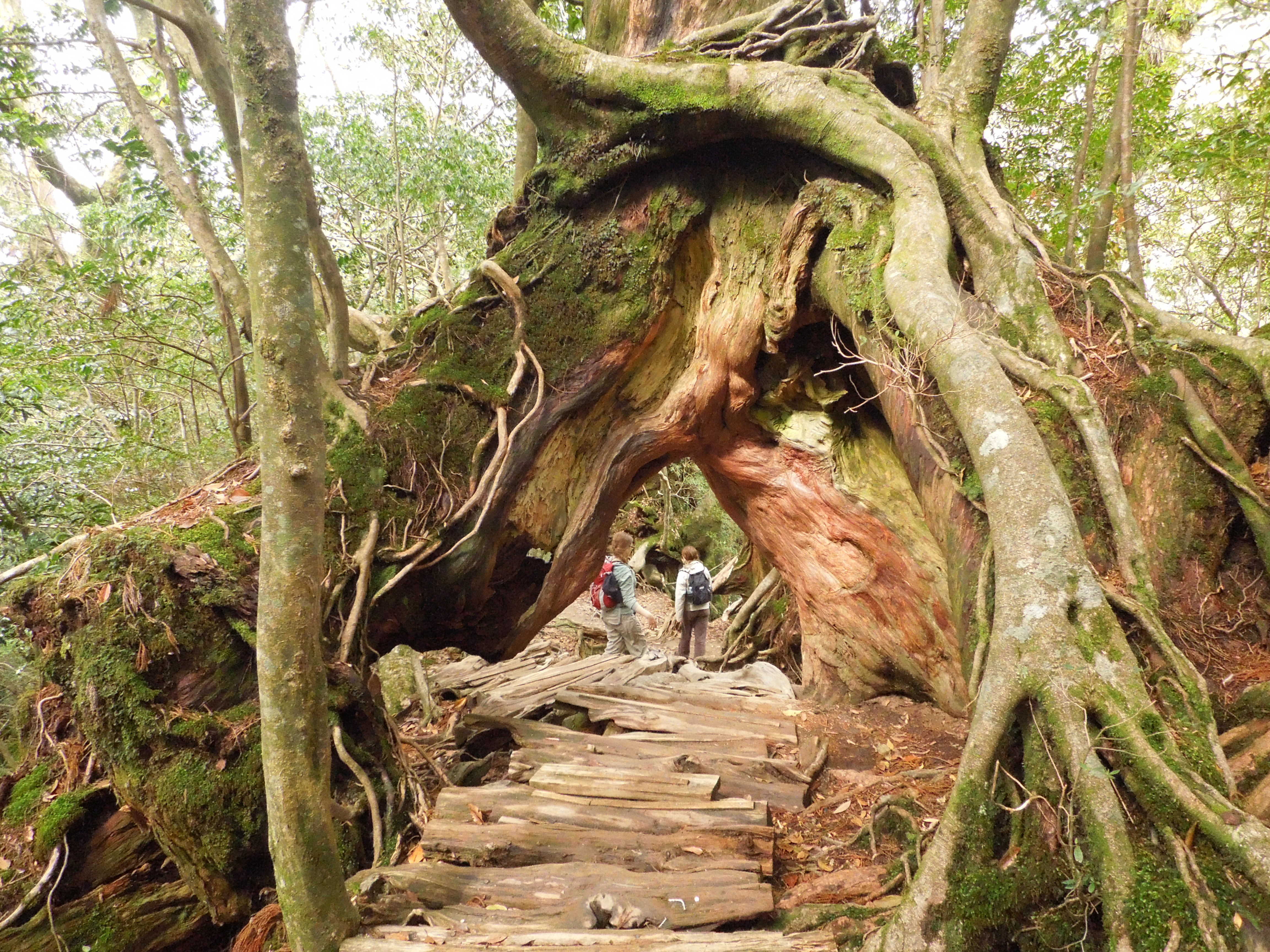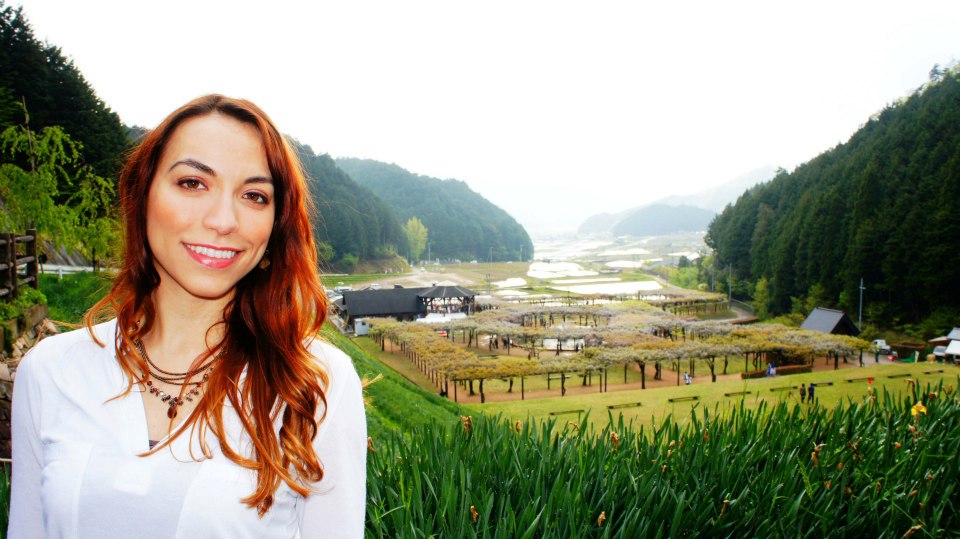You, Your Feet, and Unique Yakushima
If April’s article “The Do’s and Don’ts of Yakushima Hiking†by Paige Ngo intrigued you, read on for details about the most popular hikes on Yakushima and getting around the island without a car!
First things first: don’t expect your typical walk in the woods!
 The many forces of nature combine to make Yakushima a unique experience. In addition to the beautiful vistas and natural scenery, Yakushima is home to several ancient Japanese cedar trees, more than 1,000 years in age, reverently referred to as Yaku Sugi. The island’s natural landscape was also the inspiration for the famous Miyazaki film, “Princess Mononokeâ€. After hiking for a few hours in San’s original stomping grounds, you might even see a kodama!
The many forces of nature combine to make Yakushima a unique experience. In addition to the beautiful vistas and natural scenery, Yakushima is home to several ancient Japanese cedar trees, more than 1,000 years in age, reverently referred to as Yaku Sugi. The island’s natural landscape was also the inspiration for the famous Miyazaki film, “Princess Mononokeâ€. After hiking for a few hours in San’s original stomping grounds, you might even see a kodama!
Exploring Yakushima without a car is possible!
Public buses can take you from the major port towns (Miyanoura and Anbo) to the most popular hiking trailheads. The difficult part is the scheduling; most buses only run a few times per day. However, if you’re willing to commit a few extra minutes to logistics, you’ll see that the bus schedules are intentionally planned to align with the estimated time it takes to complete the major hikes. Additionally, you’ll find many taxis on the island along with clear, pre-set prices for popular routes.
Shiratani Unsuikyo Gorge
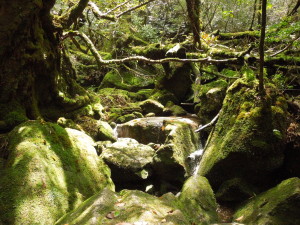 Estimated time from trailhead to Taikoiwa Rock = 220 minutes/ 150 minutes (~6 hours)
Estimated time from trailhead to Taikoiwa Rock = 220 minutes/ 150 minutes (~6 hours)
Distance (roundtrip): 11.6 kilometers, 7.2 miles
Starting Point: Kusugawa Trailhead
Access: By taxi from Miyanoura 2,750円 (all prices in yen), ~ 30 minutes
Return: Take a bus back to Miyanoura or Anbo, ~500円
Terrain: Dirt and rocks, wooden boardwalks, wooden stairs
Cost: 300円 entrance fee at the trailhead
The Shiratani Unsuikyo Gorge is accessible via the Kusugawa Trail. Kusugawa boasts patches of dense forest and remnants of the old “sidewalk†built by loggers’ wives who carried chopped cedar shingles out of the woods. There is a section of the trail that runs through the Princess Mononoke Forest. Several sources state that this patch of forest was landscaped to resemble scenes from the movie. Regardless, the entire trail is stunning with plenty of places to rest and enjoy the beauty that surrounds you.
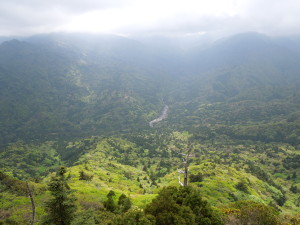 Most people hike to the Mononoke Forest and turn back, but for those with extra time, the true visual feast is at Taikoiwa Rock. To reach the rock, continue past the Monoke strip and brace yourself for a very steep twenty-minute climb up the mountain. You’ll break through the bushes and suddenly find yourself on top of a large rock, jutting out over the valley. The view is incredible with a horizon eerily obscured by shifting clouds. The density of the tree tops below you makes the forest canopy look like gently rolling hills. The wind can be a bit strong up here, so pack a thin, warm layer.
Most people hike to the Mononoke Forest and turn back, but for those with extra time, the true visual feast is at Taikoiwa Rock. To reach the rock, continue past the Monoke strip and brace yourself for a very steep twenty-minute climb up the mountain. You’ll break through the bushes and suddenly find yourself on top of a large rock, jutting out over the valley. The view is incredible with a horizon eerily obscured by shifting clouds. The density of the tree tops below you makes the forest canopy look like gently rolling hills. The wind can be a bit strong up here, so pack a thin, warm layer.
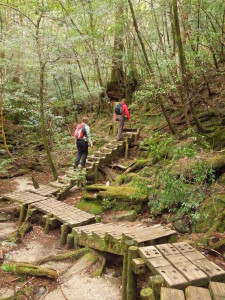 Jomon Sugi
Jomon Sugi
Estimated time from Arakawa trail > Okabu trail > Jomon Sugi and return = 290 minutes/ 270 minutes (~9.5 hours)
Distance (roundtrip): 24.2 km, 15 miles
Starting Point: Arakawa trailhead
Access: By bus from Miyanoura, 1,380円
Return: By bus from Arakawa trailhead, 1,380円
Terrain: Old wooden railroad tracks, dirt and rocks, lots of wooden stairs
Cost: Suggested donation upon returning to the trailhead ~400円
You’ll need to devote an entire day to Yakushima’s most famous and most challenging hike: the ten-hour roundtrip trek to Jomon Sugi, the oldest cedar tree in the forest. The trail begins in the small town of Anbo at the Arakawa trailhead. At first glance, the bus schedule seems hideous because of the early and infrequent times. However, considering the length of the hike, Yakushima’s public transportation service has actually done quite a good job of setting you up for an adventure. From Miyanoura, you’ll catch the first bus at 4:30 am, switch buses at the Yakusugi Shizenkan Museum, and arrive at the Arakawa trailhead around 6:00 am.  Then, you have ten hours to complete the loop before the last bus departs from the trailhead at 4:00 pm. We returned a little before 3:00 pm and there was an unscheduled bus waiting for hikers.
If, like me, you’re not a morning person, try to mitigate your pre-dawn grumpiness by enjoying the camaraderie of the hiking community. It’s motivating to see other hikers and backpackers slowly wandering towards the bus stop. At the bus switch, you’ll purchase a second ticket and line up with the crowd. Multiple buses are in service to assist all the hikers – so don’t worry if several full buses depart without you. Once at the trail head, join in as groups start the morning with stretches, yoga and motivational cheers.
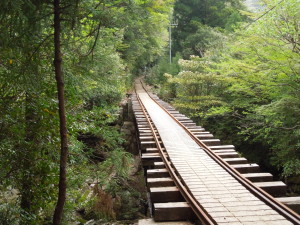 The first two and a half hours of the hike follow the tracks of the old railroad. In the early 1900s when the forest was heavily harvested, the railways were used to transport giant cedar trunks. This part of the trail is a mixture of eerie and boring. The tracks curve around the sides of the mountain, crossing powerful rivers and gorges. Like most nature hikes in Japan, there are no barriers, no railings, nothing to stop you from falling off the countless bridges and suspended tracks. Every so often you’ll see scraps of metal ripped up from the old rails or forgotten pieces of new tracks never built, hidden among the foundations of abandoned towns.
The first two and a half hours of the hike follow the tracks of the old railroad. In the early 1900s when the forest was heavily harvested, the railways were used to transport giant cedar trunks. This part of the trail is a mixture of eerie and boring. The tracks curve around the sides of the mountain, crossing powerful rivers and gorges. Like most nature hikes in Japan, there are no barriers, no railings, nothing to stop you from falling off the countless bridges and suspended tracks. Every so often you’ll see scraps of metal ripped up from the old rails or forgotten pieces of new tracks never built, hidden among the foundations of abandoned towns.
About halfway along the trail, the railroad disappears and you will enter a dense forest area, beginning the ascent up into the mountains. The path here is rougher, with lots of stones and climbing as well as a series of tall wooden staircases. The vegetation is thicker and previously forgotten paths and sunken bridges are visible in places.
Less than two hours before the trail’s end, you’ll come across Wilson’s Stump.  Circa 1912, English botanist Ernest Henry Wilson explored Yakushima and “discovered†a giant cedar tree stump. He estimated that when the tree was cut down, sometime in the 1500s, it was over 3,000 years old. The stump has a diameter of 4.3 meters (14 feet). At least twenty visitors can enter through an arch in the wooden walls at the same time.
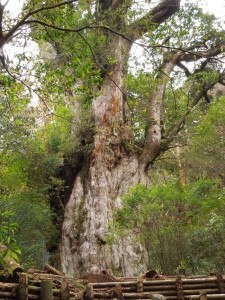 After another long series of stairs, lined with small wooden platforms perfect for picnicking, you will finally crest the hill and see Jomon Sugi. This wooden king of the forest is named after the Jomon Period. Scientific tests place Jomon’s age at about 2,170 years while natural judgments based on the tree’s height and girth suggest an age of 7,000 years. Due to conservation efforts, an ugly chain link fence protects Jomon. Visitors can stand on a platform about thirty feet away from the tree. If I’m being honest, I thought Taikoiwa Rock was more impressive. Still, seeing Jomon after our intense, five hour hike deep into the forest was a rewarding experience and a worthy accomplishment to reflect on as we made the return journey.
After another long series of stairs, lined with small wooden platforms perfect for picnicking, you will finally crest the hill and see Jomon Sugi. This wooden king of the forest is named after the Jomon Period. Scientific tests place Jomon’s age at about 2,170 years while natural judgments based on the tree’s height and girth suggest an age of 7,000 years. Due to conservation efforts, an ugly chain link fence protects Jomon. Visitors can stand on a platform about thirty feet away from the tree. If I’m being honest, I thought Taikoiwa Rock was more impressive. Still, seeing Jomon after our intense, five hour hike deep into the forest was a rewarding experience and a worthy accomplishment to reflect on as we made the return journey.
Yakusugi Cedar Land
Estimated time to circuit the park = 150 minutes
Distance: 3.2 km, 1.9 miles
Starting Point: Park entrace
Access: By bus from Miyanoura, 1,310円
Return: By bus from park entrance, 1,310円
Terrain: Wooden stairs, earthen trails
Cost: 300円 entrance fee
The Yakusugi Cedar Land Park is home to about a dozen yakusugi trees.  Here, the paths are well maintained and the hiking is reduced to a “walking trailâ€. This is where people come to see yakusugi without trekking for hours. We were expecting a calm pleasant morning and afternoon in the park but the weather did not allow it. What started as steady rain quickly became a torrential downpour. We only spent a few hours inside the park, navigating a simple trail that quickly turned into a flooded obstacle course. The hikes around the park are well labeled with names and estimated times. There are small covered shelters along the way. The visitor’s center has a rest area on the second floor but does not offer food or drinks, save for the vending machine. We took the earliest bus to the park, lumbered through the pouring rain for a few hours, and then sat in the visitor’s center for several more hours until the next bus arrived.
When returning to Hyogo, consider pausing at Kagoshima Port to hop on the ten-minute ferry to Sakurajima, the volcanic island in the middle of Kagoshima Bay. The volcanic activity on the island creates interesting attractions including volcanic foot baths. There is a bus system that circles the main attractions on the bay side of the island. The bus will pause at all the observation points for five to ten minutes, so you can plan to make one loop on the same bus, finishing at the ferry port.
To have the most unique Yakushima experience possible, tailor your itinerary to fit your needs. Don’t forget to consider buses before renting a car and know that the taxis services are friendly, trustworthy, and dependable.
Claire Bronchuk
Sources:
Trek map: http://www.yakukan.jp/doc/pdf/e_tozanmap.pdf
Taxi/ bus prices: http://www.yakumonkey.com/2007/06/moving-around-yakushima.html
Hiking Map of Yakusugi Cedar Land: http://www.yakumonkey.com/2009/02/yakusugiland-yakusugiland-can-be.html
